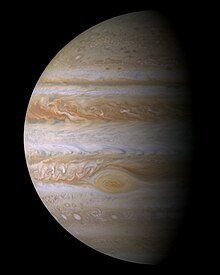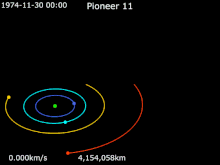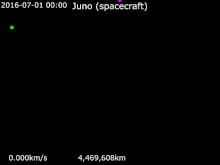Exploration of Jupiter
It began with the arrival of Pioneer 10 into the Jovian system in 1973, and, as of 2024[update], has continued with eight further spacecraft missions in the vicinity of Jupiter and two more en route.
All but one of these missions were undertaken by the National Aeronautics and Space Administration (NASA), and all but four were flybys taking detailed observations without landing or entering orbit.
Sending a craft to Jupiter is difficult, mostly due to large fuel requirements and the effects of the planet's harsh radiation environment.
The European Space Agency selected the L1-class JUICE orbiter mission in 2012 as part of its Cosmic Vision programme[1][2] to explore three of Jupiter's Galilean moons, with a possible Ganymede lander provided by Roscosmos.
The Chinese National Space Administration plans to launch two Interstellar Express missions in 2024 on a flyby of Jupiter[6][7] and Tianwen-4 around 2029 to explore the planet and Callisto.
[10] Gravity assists through planetary flybys (such as by Earth or Venus) can be used to reduce the energetic requirement (i.e. the fuel) at launch, at the cost of a significantly longer flight duration to reach a target such as Jupiter when compared to the direct trajectory.
[15] Over the eight years the Galileo spacecraft orbited the planet, the probe's radiation dose far exceeded its design specifications, and its systems failed on several occasions.
The spacecraft's gyroscopes often exhibited increased errors, and electrical arcs sometimes occurred between its rotating and non-rotating parts, causing it to enter safe mode, which led to total loss of the data from the 16th, 18th and 33rd orbits.
The information gathered by these two spacecraft helped astronomers and engineers improve the design of future probes to cope more effectively with the environment around the giant planet.
They also took the first close-up images of the planet's atmosphere, revealing the Great Red Spot as a complex storm moving in a counter-clockwise direction.
[22] Two new, small satellites, Adrastea and Metis, were discovered orbiting just outside the ring, making them the first of Jupiter's moons to be identified by a spacecraft.
[32] This swing-by maneuver was required for Ulysses to attain a very high-inclination orbit around the Sun, increasing its inclination to the ecliptic to 80.2 degrees.
[33] The giant planet's gravity bent the spacecraft's flightpath downward and away from the ecliptic plane, placing it into a final orbit around the Sun's north and south poles.
It produced the most detailed global color portrait of Jupiter yet, in which the smallest visible features are approximately 60 km (37 mi) across.
Analysis of Cassini imagery showed that the dark belts contain individual storm cells of upwelling bright-white clouds, too small to see from Earth.
[37] Other atmospheric observations included a swirling dark oval of high atmospheric-haze, about the size of the Great Red Spot, near Jupiter's north pole.
On December 19, 2000, the Cassini spacecraft captured a very-low-resolution image of the moon Himalia, but it was too distant to show any surface details.
[43] On March 19, 2007, the Command and Data Handling computer experienced an uncorrectable memory error and rebooted itself, causing the spacecraft to go into safe mode.
[47] Cameras on the Galileo spacecraft observed fragments of Comet Shoemaker–Levy 9 between 16 and 22 July 1994 as they collided with Jupiter's southern hemisphere at a speed of approximately 60 kilometres per second.
The Galileo orbiter itself experienced a more rapid version of the same fate when it was deliberately steered into the planet on September 21, 2003, at a speed of over 50 km/s,[45] in order to avoid any possibility of it crashing into and contaminating Europa.
[4][66] In 2012, the European Space Agency's selected the JUICE as its first Large mission, replacing its contribution to EJSM, the Jupiter Ganymede Orbiter (JGO).
[69] China's CNSA is planning to launch its two Shensuo (formerly Interstellar Express) spacecraft in 2026 to flyby Jupiter on the way to explore the heliosphere.
[75] Its main objectives included determining the presence or absence of a subsurface ocean and identifying candidate sites for future lander missions.
While scientists require further evidence to determine the extent of a rocky core on Jupiter, its Galilean moons provide the potential opportunity for future human exploration.
[86] In the Vision for Space Exploration policy announced in January 2004, NASA discussed missions beyond Mars, mentioning that a "human research presence" may be desirable on Jupiter's moons.
"[88] The Jovian system in general poses particular disadvantages for human missions because of the severe radiation conditions prevailing in Jupiter's magnetosphere and the planet's particularly deep gravitational well.
[91] According to this plan, explorers would drill down into the Europan ice crust, entering the postulated subsurface ocean, where they would inhabit artificial air pockets.
The possibility of building a surface base on Callisto was proposed, because of the low radiation levels at its distance from Jupiter and its geological stability.
The levels of ionizing radiation on Io, Europa and long-term on Ganymede, are hostile to human life, and adequate protective measures have yet to be devised.
[85][93] NASA has speculated on the feasibility of mining the atmospheres of the outer planets, particularly for helium-3, an isotope of helium that is rare on Earth and could have a very high value per unit mass as thermonuclear fuel.



Pioneer 11 · Jupiter · Io · Europa · Ganymede · Callisto




Galileo · Jupiter · Io · Europa · Ganymede · Callisto


